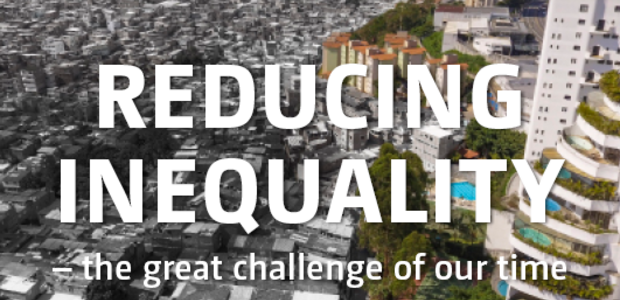Working Paper
How polarized is the global income distribution?
The interest in the level of global inequality has surged in recent years. This paper complements existing estimates of global inequality by providing the first estimates of the level of bipolarization of the global income distribution. During 1975...
In the media
World Economic Forum features UNU-WIDER study on global inequality
The recent study on global inequality by UNU-WIDER experts has drawn the attention of the World Economic Forum. Laurence Roope, Miguel Niño-Zarazúa, and Finn Tarp write in their column for the forum and vox.org about how absolute inequality has...
Presentation
Global Interpersonal Inequality - What do we know?
Presentation
Thu, 12 December 2013
Beijing Normal University,
19 Xinjiekou Outer St,
Haidian, Beijing,
China
Past event
Presentation
Global governance and sustainable development: revitalizing research to support multilateral solutions
UNU-WIDER is represented at the 2024 Annual Meeting of the Academic Council of the United Nations (ACUNS) by Rachel M. Gisselquist, where she will share research findings on addressing gender and group-based inequalities and multilateral efforts to...
Thu, 20 June 2024
–
Sat, 22 June 2024
United Nations University – Tokyo,
5-53-70, Jingumae, Shibuya-ku,
Tokyo,
Japan
Past event
Policy seminar
Global inequality – Trends and issues
On April 17th Professor Finn Tarp, Director of UNU-WIDER, delivered a seminar entitled 'Global Inequality – Trends and Issues' at SIDA HQ in Stockholm. The seminar highlighted recent UNU-WIDER research on the topic of inequality. Professor Tarp was...
Fri, 17 April 2015
SIDA,
Valhallavägen 199,
Stockholm,
Sweden
Past event
Project
World inequality
Theme: 2014-15
The purpose of this project is to advance data collection, measurement, and research regarding the development of inequality in the world. A major focus in this research area is the maintenance, updating, and development of the World Income...
In the media
Global income inequality down in relative terms, up in absolute sums - Oxford University reports on UNU-WIDER study
Oxford University reports on UNU-WIDER research found that during the last four decades global income inequality decreased substantially in relative terms, but increased markedly in absolute terms. The study, published this week in the Review of...
In the media
Recent UNU-WIDER study on global inequality continues to grab attention
News outlets continue to cover a recent UNU-WIDER study on global inequality.
Presentation
Measuring Inequality in the 21st Century
The Human Development Report Office, LIS, the Stone Center at the City University of New York (CUNY), UNU-WIDER and the World Inequality Lab will host a symposium on Measuring Inequality in the 21st Century. The 2-day event will be held 28-29 March...
Thu, 28 March 2019
–
Fri, 29 March 2019
United Nations Headquarters ,
New York,
United States
Past event
Panel discussion
 Open dialogue on inequality in the 21st century
Open dialogue on inequality in the 21st century
Fri, 29 March 2019
Ex-Press Bar, Third Floor of the General Assembly, United Nations Headquarters,
1st Avenue at 46th Street,
New York,
United States
Past event
Presentation
Pia Rattenhuber's keynote speech at UNU-FLORES United Nations Day 2021 commemorative event
United Nations University Institute for Integrated Management of Material Fluxes and Resources (UNU-FLORES) organizes a commemorative event in Dresden on the occasion of the UN day 2021. The topic of the event is Inequalities in crises. UNU-WIDER...
Tue, 5 October 2021
Plenary Hall, City Hall,
Dresden,
Germany
Past event
Programme
Conference programme: Reducing inequality – the great challenge of our time
Programme for Reducing inequality – the great challenge of our time To watch the videos from the sessions at the conference, watch our playlist here. Spanish version of the programme here. *CEC indicates that this session is part of the VII Colombian...
Workshop
Carlos Gradín at the UN-ESCAP Expert Group Meetings on Building Forward Fairer
The United Nations Economic Commission for Asia and the Pacific (UNESCAP) holds a 3-day virtual conference to convene experts on social and economic policy for an inclusive recovery and inclusive development. The Expert Group Meetings invite speakers...
Fri, 3 December 2021
Online,
Bangkok,
Thailand
Past event
Conference
 Reducing inequality – the great challenge of our time
Reducing inequality – the great challenge of our time
Wed, 5 October 2022
–
Fri, 7 October 2022
Universidad de los Andes,
Carrera 1, Calle 18a,
Bogotá,
Colombia
Past event
Impact
The WIID – an important source for the UN Economists Network report for the 75th Anniversary of the United Nations
New York, 17 September - The UN's top economists warned of crises of our own making if global 'megatrends' are left unchecked in a special report on six global megatrends. In a press release, UNDESA said, 'the chief economists in the United Nations...

 Join the network
Join the network





